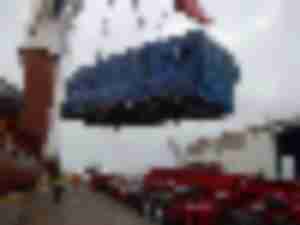Porcari outlines Biden Administration’s initiatives to reduce port congestion
John Porcari, the Biden-Harris Administration’s Port Envoy, warned that long-standing shortfalls in U.S. infrastructure spending going back generations have created a reliance on an infrastructure “that our grandparents built.”
California Governor Newsom proposes $2.3 billion for California ports and congestion reduction
California’s Governor Gavin Newsom is proposing $2.3 billion in state funding to help ease congestion and supply chain problems that continue to impact the California Ports of Los Angeles, Long Beach and Oakland.
A Kodak moment for automotive - and not in a good way for some
Is the automotive industry on the precipice of being trampled by the forward march of technology?
AI and predictive analytics: Powerful ways to minimize container contingencies
Most empty container are stagnant on vessels waiting in fast-growing lines at ports to get offloaded, meaning even more congestion and creating extreme bottlenecking throughout the supply chain.
Port of LA’s Seroka says fees may be levied against empty containers
As the backlog of import containers at container terminals has declined, Eugene Seroka, executive director Port of Los Angeles, said the Port is turning its attention to the backlog of empty containers and may impose fees on empty containers that dwell on terminals “excessively.”
How to prepare for global logistics in 2022
Mike Short, president of global forwarding at C.H. Robinson, shares his perspective on how shippers can approach logistics in 2022.
Maersk will build eight 16,000 TEU ships powered by methanol
A.P. Moller-Maersk announced on December 8th that it will be building eight 16,000 twenty-foot unit (teu) container ships powered by “carbon-neutral methanol” with an alternative capability for low sulphur diesel fuel
FDA: U.S. food exporters to China must file “facility registration requirements” before January 1, 2022
The new Chinese Customs requirements go into effect on January 1st, 2022 and the FDA is asking food exporters to China to submit information to the FDA by December 17th, 2021 to meet the Chinese deadline.
Port of Oakland’s Wan & Brandes see recovery in sailings
After experiencing a decline in ocean carrier sailings over the last several months, the Port of Oakland is starting to see an uptick in sailings and volumes, according to Port of Oakland executive director Danny Wan.
How to tune your port IT for maximum productivity
Running a port is like conducting an orchestra. When everything runs in harmony, it’s like a symphony on the deck. And the conductor behind this masterpiece? Well, it’s your IT system. Find out how you can tune the different elements to boost port productivity.
© Copyright 1999–2025 American Journal of Transportation. All Rights Reserved











